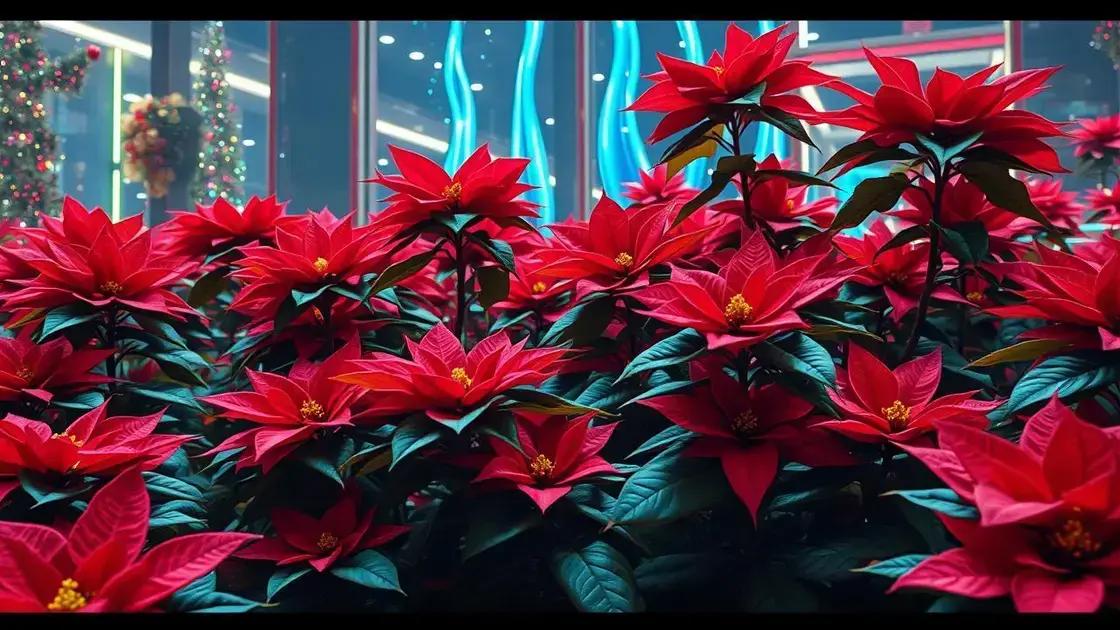How to Care for a Poinsettia Plant Year Round: 7 Secrets Revealed
How to care for a poinsettia plant year round may seem daunting, but with the right tips, you can keep your plant healthy and gorgeous. Many people appreciate the beauty of this seasonal favorite but may struggle with its year-round care. Let’s explore the essential techniques that will make your poinsettia thrive no matter the season.
Table of Contents
ToggleEssential tips for poinsettia watering throughout the year
Effective watering is crucial for how to care for a poinsettia plant year round. Proper moisture levels ensure that your poinsettia thrives, encourages growth, and maintains vibrant blooms.
Understanding your plant’s watering needs
Poinsettias prefer slightly moist, well-draining soil.
- Water when the top inch of soil feels dry.
- Use room temperature water for best results.
- Avoid letting the plant sit in water, as this can lead to root rot.
Seasonal watering variations
Watering frequency may change throughout the year:
- Winter: Water less frequently; allow the soil to dry out more between waterings.
- Spring and Summer: Water regularly as they actively grow and need more moisture.
- Fall: Begin to reduce watering as the plant prepares for dormancy.
Signs of improper watering
It’s essential to watch for signs indicating your poinsettia’s watering needs:
| Signs | Possible Issue |
|---|---|
| Yellow leaves | Overwatering |
| Crispy edges | Underwatering |
| Wilting | Both over and underwatering can cause wilting |
Additional tips for success
For enhanced success in your gardening journey, consider exploring indoor gardening techniques. Here are a few bonus tips:
- Use a pot with good drainage.
- Monitor humidity levels to keep your plant comfortable.
- Adjust your watering schedule if your environment changes.
Optimal light requirements for thriving poinsettias

Understanding the optimal light requirements for thriving poinsettias is essential for their health and beauty. Proper lighting can make a significant difference in how your poinsettia grows and blooms.
Best lighting conditions for poinsettias
Poinsettias thrive best in bright, indirect light. Here are some key tips for providing the right lighting:
- Place the plant near a window with filtered sunlight.
- Avoid direct sunlight to prevent leaf scorch.
- Rotate the plant weekly for even light distribution.
Adjusting light based on seasons
As the seasons change, so do your plant’s lighting needs:
- Winter: Ensure they receive at least 8 hours of bright light daily.
- Spring and Summer: Provide more light as days lengthen, but ensure it’s indirect.
- Fall: Gradually reduce light exposure as they prepare for dormancy.
Signs your poinsettia needs more light
Keep an eye on your plant’s appearance for signs that adjustments may be necessary:
| Signs | Recommended Action |
|---|---|
| Stretching stems | Increase light exposure |
| Faded color | Move to a brighter location |
| Leaf drop | Evaluate and adjust light conditions |
Supplementing light during low-light periods
During darker months or in less brightly lit homes, consider exploring indoor gardening techniques that include:
- Using grow lights to maintain brightness.
- Positioning the plant strategically to maximize natural light.
- Monitoring the plant to ensure it’s thriving in its environment.
Understanding common poinsettia problems and solutions
Understanding common poinsettia problems and solutions is vital for maintaining healthy plants. Identifying issues early can help you take corrective actions to keep your poinsettia thriving.
Identifying common issues with poinsettias
Poinsettias can face various challenges; here are some of the most frequent problems:
- Leaf drop
- Wilting
- Yellowing leaves
- Stunted growth
Leaf drop: Causes and solutions
Leaf drop can be a concerning sign. It often indicates underlying problems:
- Improper watering: Check for over or underwatering.
- Temperature fluctuations: Ensure stable temperatures, avoiding drafts.
- Lack of light: Make sure your plant receives the right amount of indirect sunlight.
Wilting: What to look for
Wilting can result from several factors:
| Observation | Potential Cause | Recommended Action |
|---|---|---|
| Drooping leaves | Underwatering | Increase watering frequency |
| Soft, mushy leaves | Overwatering | Reduce watering and check drainage |
Yellowing leaves: Understanding the problem
Yellowing leaves may indicate various issues:
- Overwatering or underwatering
- Nutrient deficiencies
- Insufficient light
To resolve yellowing leaves, assess your watering routine and consider fertilizing with a balanced houseplant fertilizer.
Stunted growth: What to do
Stunted growth is often a sign of stress. Check on these factors:
- Pot size: Ensure your poinsettia isn’t root-bound.
- Environmental conditions: Adequate light, temperature, and humidity are essential.
For additional resources, consider exploring indoor gardening techniques to better manage your plant’s environment.
In conclusion
Caring for a poinsettia plant year round involves understanding its specific needs, including optimal watering, light requirements, and recognizing common problems. By applying the tips shared in this guide, you can ensure your poinsettia remains vibrant and healthy throughout the seasons. For more great advice, check out these tips on enhancing your indoor garden to create a flourishing space in your home.

